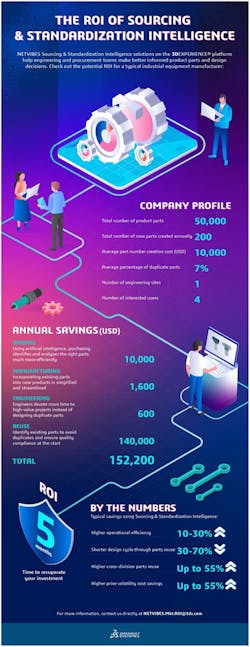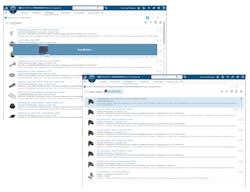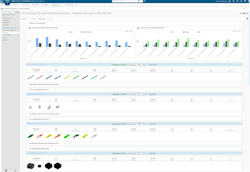What you’ll learn:
- The consequences of inadequate parts data and outdated sourcing procedures.
- How intelligent sourcing via AI and machine learning can unify data systems, streamline access, and speed product design execution.
Most products are incremental improvements on a previous version. Many parts in a new product can be reused from past work. Research shows reusing a previously specified part can save anywhere between $4,500 and $23,000 per part, on average. And the savings don’t stop there.
According to a recent report by Tech Clarity, engineers spend about 33% of their time on non-value-added work such as searching for existing parts within the company that can be reused, or designing/recreating a new part because an existing one doesn’t exist or (more likely) can’t be found in a timely manner. If a manufacturer can reduce the time spent searching for or designing parts, the savings multiply.
Parts Pursuit
Parts data is usually stored in multiple locations—the proverbial silos—and formats. And even if the silos have been broken down, existing search methods for parts rely on keywords, attributes, or (less often) key shape inquiries. If the words or shapes aren’t exact, or if the relevant data hasn’t been manually added to a database, an engineer could easily be led to believe the required part isn’t in the company database or otherwise accessible.
Adding a new part to the company’s ecosystem takes longer to source parts for a new product. This means that projects take longer to reach the market and cost more to build.
Not too long ago, I was speaking to a design engineer about his daily activities. “When I needed a part,” said the engineer, “I would sometimes search for an hour before I gave up and designed a new one.”
In this example, the engineer had to comb through multiple unique engineering data vaults created by two software vendors, as well as the company’s ERP and MRP systems created by two other vendors. “With intelligent sourcing in place, I can now create a rough design with the key criteria I need in just a couple of minutes. By simply uploading the model to the search window, the geometric search results show me existing parts I can use in seconds.”
Inadequate data about parts and inadequate access to sourcing parts create four structural problems within the organization:
- Operational inefficiency: Dispersed parts information entails the use of a wide variety of search techniques, including reading long lists.
- Poorly informed make-or-buy decisions: The engineer quoted above believed that his time was the only resource in question, resulting in limited patience to seek out previously sourced parts.
- No cross-program standardization: The more projects in an organization, the greater the likelihood one of those programs has previously sourced parts another project could utilize. But without standardization, engineers are often flying blind in their searches for proven parts.
- Weak procurement performance: Inefficient internal sourcing forges a weak link in the supply chain that can be hard to remove. Once it has been “documented” that a part isn’t available internally, it becomes “fake news” and hard to correct.
Intelligent Sourcing
The solution is intelligent sourcing. The use of artificial intelligence (AI) and machine learning (ML) offers the opportunity to unify separate and unstructured data systems, allowing for streamlined access to data, better decisions, and faster design execution.
AI/ML algorithms can simplify organizing all of the data in the enterprise. The goal is to get a comprehensive view of all parts, whether internal or external to the organization. The new generation of intelligent-sourcing software can identify not only if a part is available, but if there are multiple vendors for it, check for cost differences, and compare for subtle variations not initially obvious.
Using intelligent sourcing does more than identify parts across disparate data silos. It also can extend the life of these existing silos by postponing or eliminating the need to replace them with a more modern approach. Don’t toss out your ERP, MPR, or PLM; instead, use an algorithmic solution to find what’s already there.
AI for sourcing is agnostic to CAD and PLM standards. It can be trained to be very efficient in identifying shape and feature similarity. It provides a holistic view of the organization’s internal and external parts, without having to move from one kind of dashboard to another.
Your content isn’t replicated into a new system—it stays where it is. This means your existing business processes and security are maintained. If you are subject to ITAR or export control regulations, this is a huge consideration. Intelligent sourcing also allows engineering teams to discover parts and related information without another division having to relinquish control.
AI for sourcing offers a solution to the four structural impediments listed above. Operational efficiency improves as data silos no longer stand in the way of finding information. Reuse is simpler and make-or-buy decisions are based on complete knowledge. Standardization becomes possible as all of the variations in available parts are revealed.
Matt Rose, IT Analyst with intelligent power management company Eaton, explains, “Certainly one of the most powerful features we’ve brought in has been the Exalead search module and the immediate impact that had on our engineers using it. Even a week after deployment, we were getting praise from some of our custom-order engineering team that ‘we’re finding parts and able to reuse parts that we would never have been able to find previously.’…I wish we could’ve had that 10 years ago.”
Procurement becomes stronger when based on accurate information, strengthening the relationship between engineering and procurement, and enabling the latter to negotiate better deals and improve supply chains. In summary, engineers, designers, and procurement professionals are empowered to quickly make the best decision, freeing up the time previously wasted searching for the right parts, devoting it instead to creating new and better products.



